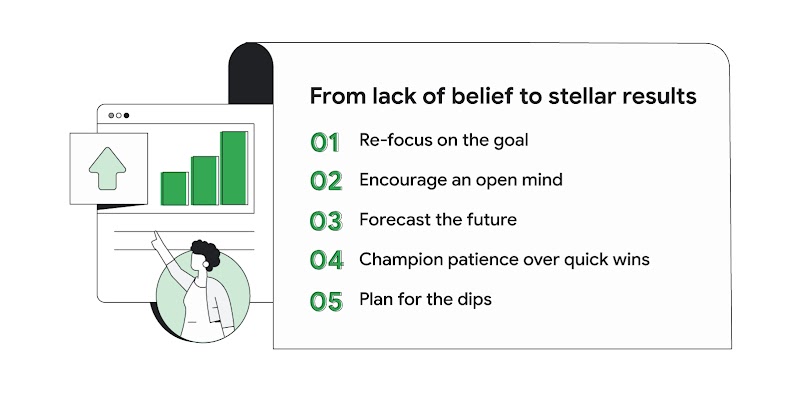We’ve introduced a new audio narration feature to make our articles more accessible. Click to listen to the full article. Enjoy!
Michael Benjamin is Director of Marketing (U.K.) at financial software company Intuit, maker of QuickBooks and MailChimp. He joined the business in 2023 with the goal of driving growth while reducing costs.
As a newcomer to the company, it was not exactly the sort of proposal to win me fans: increase QuickBooks’ peak-season new-customer acquisition from Google paid search by 20% year-on-year in the U.K., while shrinking advertising Cost Per Acquisition (CPA).
I was met with scepticism. Indeed, the target would double our typical growth rate. “The most we can do is 15% and it’ll cost more,” some colleagues said. But AI plays by different rules – I knew that AI-powered ads had the potential to reduce our CPA, something which could allow us to capture more demand for the same spend.
Three months before the crucial January Self-Assessment deadline, when U.K. businesses clamour to search for book-keeping and accounting software, we began testing an AI-powered search advertising strategy in Search Ads 360, using dynamic investing to capture emerging consumer demand.
By the time QuickBooks’ key season came around, we were able to hit and surpass our growth target with a hefty 45% year-on-year increase in peak-season new-customer acquisition, and at a lower CPA.
The team had gone from lack of belief to stellar results. But how?

1. Re-focus on the goal
In any discipline, smart staff tend to develop a thorough understanding of the parameters for any frequent challenge - and they often hold on to that understanding. But, rather than start with the parameters and limitations as you have come to understand them, focus instead on your ultimate goal.
Don’t think about the current resources, budget, or norms — focus on the big goal, then work backward by identifying the dependencies required to get there.
In our case, there was a reluctance to deviate from the tried and tested. But setting a new target galvanised minds. When you take the fresh approach, suddenly, the questions become “What would this take?” and “What do we need to test, to learn?”
2. Encourage an open mind
I didn’t demand my team believe in the goal right away — just that they should be willing to explore it, to question their assumptions. That is doubly important now that we have technology like AI, which up-ends old assumptions.
Foster a challenger mindset by encouraging a discovery phase during which colleagues can positively test for ways in which the goal may be achievable.
My staff came back with a bold plan: we could achieve supercharged growth, profitably, by implementing value-based bidding, a strategy that optimises towards customer lifetime value (cLTV) , and broad match, which allows ads to be placed not only on specific keywords but also related keywords.
3. Forecast the future
If we could attract customers at a lower CPA, it would give us the option to even exceed our new target, by choosing to spend more on advertising. An agile budget is always a big ask. But our team had a deeply-researched understanding of the business accounting software market – that gave us confidence in our expectation of seasonal search demand for our product.
We held hands with finance to forecast the whole financial year, including identifying our CPA ceilings for a range of hypothetical customer acquisition rates. In other words, we put a window of predictability around how much we were willing to spend to acquire a new customer.
Demonstrating a clear understanding of the opportunity and proactively addressing potential concerns is the best way to build trust and confidence in your strategy.
4. Champion patience over quick wins
After the investment decision, AI implementation takes time, effort, and resilience — from engineering, analytics, and other colleagues. It’s a heavy lift, with an uncertain prize at the end.
Flipping the “on” switch is only the start. Developing your long-term plan requires a period of testing and learning. In fact, when it comes to AI, the system itself often needs to start by learning from campaign performance metrics.
Along the way, look at the results the data is showing. Is it on a trajectory to your goal? Does anything need a little recalibration, or is the hypothesis of your big bet fully off-piste?
At Intuit, we had chosen to run tests for three months, to see the positive impacts of our AI-powered search strategy. Any promising new endeavour needs some time to bear fruit. Set the time limit for results by scheduling a window of experimentation, creating willingness to work toward optimum results rather than achieve them overnight.
5. Plan for the dips
It took NASA 11 missions and countless failures to land a human on the moon. We must be willing to test, learn, and adapt, even if it means pivoting from our initial strategies. That means having a tolerance for missing the mark.
We got the finance team’s buy-in for the possibility of a quarter with lower year-on-year growth followed by a quarter with higher growth, because our forecast accounted for initial performance fluctuations due to the change in media strategy. Planning for the dip meant we never faced pressure to reverse our strategy.
But, when we did have to pivot, we did. At first, we were adamant that Target CPA was the right approach for Smart Bidding, but we struggled to increase sales volume while bringing down the CPA. So, we took a bold approach and pivoted to Target ROAS following successful tests in other countries.
Boldness doesn’t rest
I have always felt that achieving bigger wins starts with leaders who model boldness. Doing so results in a culture of risk-taking; valuable experimentation cascading down through a team.
Our experiments proved the likelihood of achieving our big advertising target. By late December, we knew our ad campaigns were humming and ready to support the January peak in searches for accounting software to facilitate Self-Assessment tax returns.
My team was highly galvanised by the confidence it had built across the business. But you can’t stay in that moment — the need for growth is constant.
Our experience proved that a new, bolder way of thinking was achievable across the business. Embracing the art of the possible isn’t easy; it takes patience and a willingness to challenge the status quo, but the rewards can be transformative.



